



Disclaimer: Editing the Windows registry always runs the risk of disaster. Accidentally delete or change this or that obscure tag deep within the registry, and you may end up with a system which won't boot, potentially requiring complete re-installation of all your software and recovery of your data from backups (you do have current backups, don't you?). Always make a backup of the registry onto removable media before editing it, and be sure to have a rescue MS-DOS boot floppy at hand in case disaster strikes. (These are precautions any Windows user should take in any case--they are not specific to the procedures described in this document.)
Second, be aware that the movie studios do not want you to be able to view DVDs from regions other than where you reside, and that Microsoft have deliberately restricted your freedom to do so by introducing an obscure lock in the DVD Player software delivered with Windows 98. Microsoft being Microsoft, the implementation of said lock is the usual laughably insecure slapdash lash-up one expects from the Redmond code kiddies and is predictably trivial to circumvent. But note that in the world of Microsoft, nothing ever stays the same for very long, so once information on how to bypass the region lock is disclosed, it's probable a future "upgrade" will introduce a different mechanism, perhaps incorporating some form of revenge on those who follow these instructions. So beware, be extra-careful your system matches the configuration described herein, and be ready to restore the registry if something blows up in your face.
Third, note that these instructions circumvent only the software region lock implemented in the standard Microsoft DVD Player, and assume the DVD decoder board in your computer does not enforce a region lock in hardware; if it does, you're out of luck unless you find a way to change the hardware region code. Many DVD decoder boards come with their own proprietary DVD player software which enforces region codes in a different manner than the Microsoft player described herein. In most cases, however, you can still use the standard Microsoft DVD player to circumvent region locking (although it may lack some features compared to the player supplied with your decoder card).
Finally, please be acutely aware that this kind of configuration
tweaking is sensitively dependent on initial conditions--tiny
differences in hardware and software configuration can turn a
sure-fire fix for one system into a firestorm of chaos on
another. This document is based on experiments performed on a
Dell Dimension XPS R400 (400 MHz
Pentium II) machine with a
Quadrant International CineMaster DVD
decoder card and an
STB nVidia
ZX display card with 8 Mb of graphics RAM. This computer was
assembled in Ireland for customer delivery in Switzerland, both
countries in DVD region code 2. File sizes, date and time, and
MD5 checksums of the DVD-related files in C:\WINDOWS
on this system are as follows:
| File Name | Size (bytes) | Date and Time | MD5 Checksum |
|---|---|---|---|
DVDPLAY.EXE
| 139,264 | 05-11-98 8:01p | CE4F4B6A2B117D02CCB49EDF15CD5A42
|
DVDRGN.EXE
| 57,344 | 05-11-98 8:01p | 1FD81038A34822F847B6BF18B4E18172
|
What you see when you explore this dark corner of your own computer (which is your property--you paid for it, and you can do anything you want with it) may differ from the example that follows; if it does, take extra care you don't snag a tripwire. In any case, all responsibility for consequences of twiddling the Windows registry as described in this document is entirely your own. Not only is this the proper way intelligent adults share information they've gleaned from close examination of products conceived to restrict their ability to share information in a global market, it avoids unnecessarily triggering Fourmilab's orbiting GlobalShieldTM Anti-Lawyer Laser, about which further details are unavailable at this time. Zot... Zot...
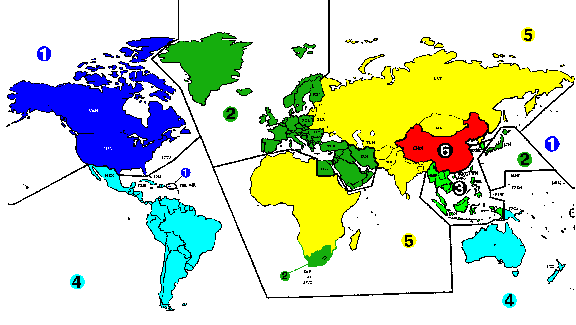
 The region code for a given disc can usually be found as a
small logo on the back of the package, a
Mollweide projection world map with the region code digit superimposed.
The logo at right is from a DVD purchased in and coded
for the United States (Region 1) which contains soundtracks in
English and French, with English, French, and Spanish subtitles.
The region code for a given disc can usually be found as a
small logo on the back of the package, a
Mollweide projection world map with the region code digit superimposed.
The logo at right is from a DVD purchased in and coded
for the United States (Region 1) which contains soundtracks in
English and French, with English, French, and Spanish subtitles.
The logo at right is from a DVD purchased in the
French-speaking
region of
Switzerland,
coded for Region 2, containing soundtracks
in English, French, and Italian, with English, French, Italian,
 and Dutch subtitles. The actual DVD disc may also bear the
region code logo, but not all do. Note that region coding
in many circumstances prevents DVDs with multiple soundtracks
from being used as language learning aids. Many DVDs sold in
North America contain only English and French soundtracks (the
latter a requirement to sell in Canada). An individual in the
U.S. who wishes to improve, for example, their Spanish language skills,
cannot order a Spanish soundtrack DVD made for sale in Latin
America (Region 4), because it won't play on a Region 1 player.
Nor could the same person practice German comprehension with a
German language disc made for Europe, yet a person living in
the United Kingdom can play Region 2 discs in all of the European
languages, but not English-language discs purchased from a
merchant in the U.S.
and Dutch subtitles. The actual DVD disc may also bear the
region code logo, but not all do. Note that region coding
in many circumstances prevents DVDs with multiple soundtracks
from being used as language learning aids. Many DVDs sold in
North America contain only English and French soundtracks (the
latter a requirement to sell in Canada). An individual in the
U.S. who wishes to improve, for example, their Spanish language skills,
cannot order a Spanish soundtrack DVD made for sale in Latin
America (Region 4), because it won't play on a Region 1 player.
Nor could the same person practice German comprehension with a
German language disc made for Europe, yet a person living in
the United Kingdom can play Region 2 discs in all of the European
languages, but not English-language discs purchased from a
merchant in the U.S.
All of this is such a mess for folks living outside Region 1 that a thriving market has sprung into being for DVD players modified to accept discs with any region code. Vendors such as CodeFree DVD offer a variety of players with region locking defeated. (I have no connection with CodeFree DVD, other than having purchased a modified Pioneer DV-606 player from them with which I am completely satisfied.) But a stand-alone player doesn't help if you wish to view DVDs using the DVD-ROM drive in your computer. So let's take a closer look at the Microsoft DVD player and see if we can work around its region locking.
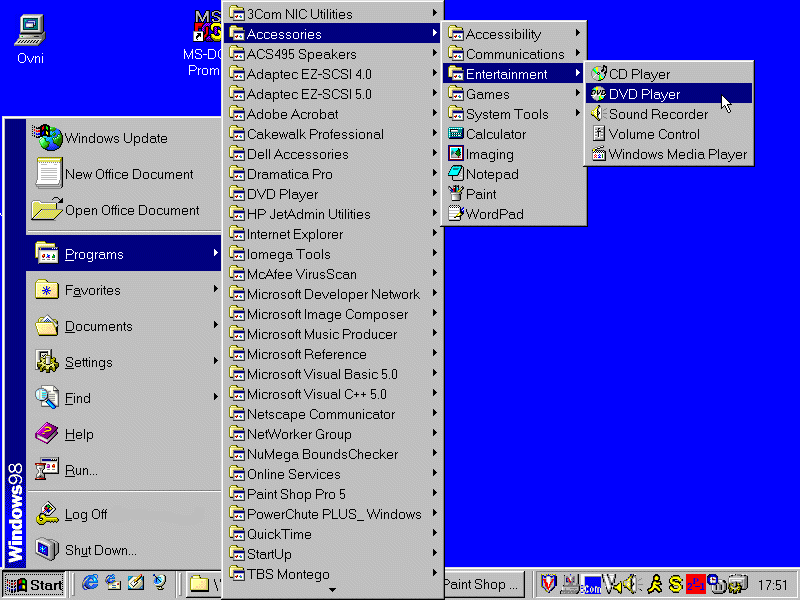
This player is, in fact, unless blocked by hardware region locking on the decoder board, able to play discs with any region code whatsoever. (Note that this may not be the case with DVD Player software supplied by the manufacturer of your decoder card; the Quadrant International CineMaster DVD card in the computer on which I prepared this document will play DVDs with any region code using the Microsoft DVD Player software and the technique I describe herein, but will only play discs with its native region code when its own DVD Player application is employed. Doubtless one could patch that program as well, but the instructions would be specific to a single manufacturer and would be useless if you have different player software.)
Note that in order to use the Microsoft (or any other) DVD Player, you may need to reduce the screen resolution to free up enough display memory to permit creation of the "video overlay plane" on which the images from the DVD appear. My computer's STB nVidia ZX display card with 8 Mb of graphics memory permits it to display up to 1600×1200 pixels in 32 bit per pixel True Colour mode, yet if the Microsoft DVD Player is launched with screen resolution set above 800×600 pixels, it fails with the following error.

This is, of course, one of Microsoft's signature "kitchen sink" error messages in which, true to form, the actual source of the problem (which I've highlighted in green) is mentioned only after several confusing misdirections. If you encounter this error, you'll have to try setting your screen to successively lower resolutions until the DVD player starts successfully. And there's one more knife in the back to contend with...Windows 98 permits you to change the screen resolution on the fly from the Control Panel/Display/Settings page, but often a change in display size doesn't propagate to the DVD decoder until you actually reboot the computer. On my computer, for example, if I change the screen resolution to 800×600 pixels then start DVD Player without rebooting, the video window appears on the screen but shows only a purple background with random white flashes; after a reboot it works OK.
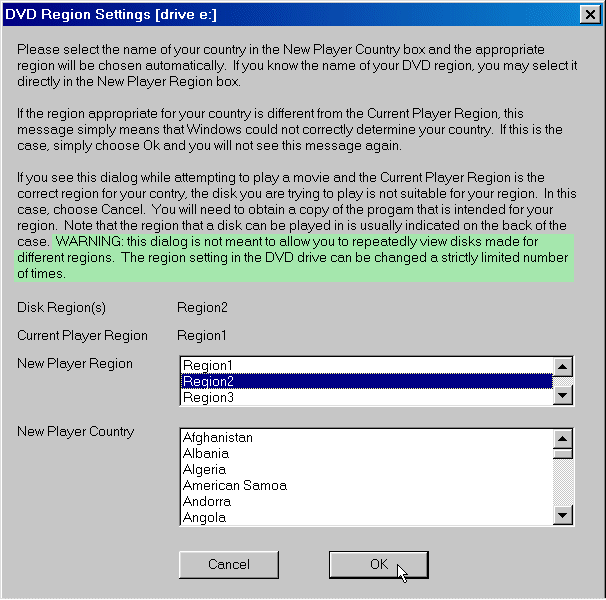
which invites you to change the region code, in this case to Region 2 for a disc purchased in Europe. Note the "WARNING", which I've again highlighted in green, obviously included at the behest of Gates' media mogul cronies (sorry, "content partners") to whom he peddles your screen space with his "active channels". If you see this dialogue, do not click OK before reading and following the instructions below. If you do innocently click OK, your disc (in this case Region 2) will play, but if you subsequently attempt to play a disc with a region code other than 2 (for example, a Region 1 disc ordered from the U.S.), you'll see the same dialogue, but this time with more of an attitude problem. When you try to change the region code back to 1, the following "Region Warning" pops up in your face.
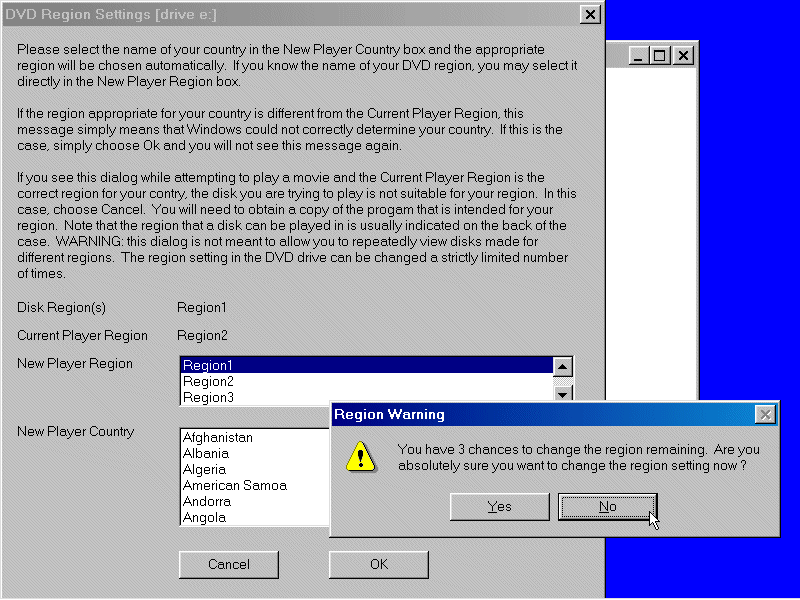
If you blithely go on changing region codes, your "chances to change the region" will count down to zero, at which point you're S.O.L.--Stuck On the Last region code you selected, unable to make further changes. Well, you could reformat your hard drive and re-install Windows from scratch, but that's a tad much in order to be granted another four region code changes. Let's look for a better way.
First of all, it is absolutely essential before attempting anything involving the registry that you make a manual backup of the registry and have a floppy at hand from which you can boot MS-DOS and repair the system in case of disaster. I'm not going you give you instructions for this--if you aren't sufficiently comfortable with Windows system administration to back up and restore the registry blindfolded, in a snowstorm, on three hours sleep, with one hand tied behind your back and a platoon of Bill Gates' robot purple dinosaurs lobbing hand grenades in your direction, you shouldn't remotely contemplate fooling around with matters such as these.
Registry backup in hand, the first step is to use the Registry
Editor (regedit) to export the registry as
an ASCII file, before changing the DVD region code. Save this
file as regback1.reg. Now launch DVD Player,
insert a disc with the region code you wish to play, change
the "New Player Region" in the "DVD Region Settings" dialogue to that
of the disc, then click OK to change the player region. (Since
this is the first time you've changed the region, the "Region
Warning" box shouldn't pop up.) Verify that your DVD now
plays properly with the changed player region.
Next, quit DVD Player and use regedit to
make a second export of the registry into file
regback2.reg. Now let's compare these two registry
dumps to see if anything interesting pops out. (I used
diff on Linux
to compare the before and after registries, but any equivalent
file compare tool will do the job. If you have a recent release
of Monkey C, you'll find it
includes a tacky "WinDiff" utility which, albeit with vintage
Microsoft opacity and lack of documentation, will get the job
done.) Since the Windows Registry is a seething,
constantly-changing cruft-cauldron, comparing any two registries
will reveal numerous changes in a variety of items, but one
intriguing difference pops right out. In the pre-region-change
registry, we had:
[HKEY_LOCAL_MACHINE\Software\Microsoft\G65320443] "v#`4"=hex:1a,1f,40,34
but following the change (to Region 2) in this case, we find this key changed to:
[HKEY_LOCAL_MACHINE\Software\Microsoft\G65320443] "v#`4"=hex:19,18,40,34
Since "Wow, let's hide the region code in an obscurely named
registry item" is about the level of sophistication
in computer security one has come to expect from the Redmond
Rugrats, this is a promising avenue to explore. So,
(clutching our original registry backup like the security
blanket it is), launch regedit once
again and navigate to the key in question:
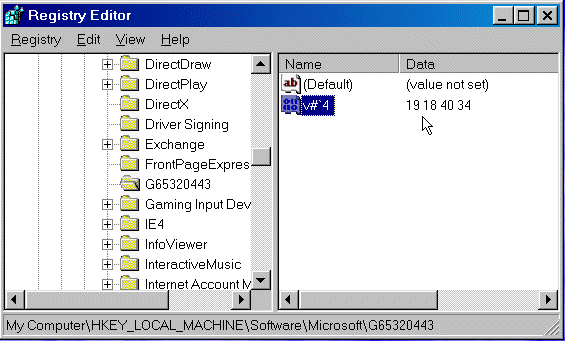
noting, upon arrival, that it still bears the value in
the export made after the change to Region 2. Now click on
the pellucidly self-documenting "v#`4" item and enter
the pre-region-code change value: 1a 1f 40 34.
(Since the last two bytes didn't change, you need only
modify the first two.) The moment you click the
OK box in regedit's "Edit Binary Value"
dialogue the value in the registry is changed, so you
should now see the item reset to its original value:
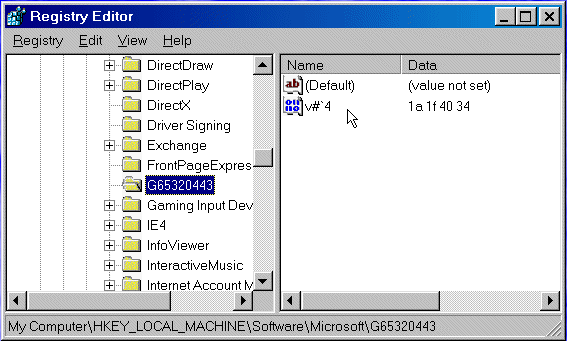
After changing the registry, launch DVD Player and confirm that it once again plays Region 1 discs and permits you to change the region code to another value without displaying the "Region Warning" shock box.
Now that you know the region code registry key and its initial
value, to play Region 1 discs, simply reset the key to that
value. To play discs from another region, insert the disc,
change the region accordingly, and when you want to go back to
Region 1 or switch to a different region, reset the key once
again to the original Region 1 value. If you do this
frequently, you might want to write a small program to reset the
registry key so you don't have to fiddle with
regedit every time.